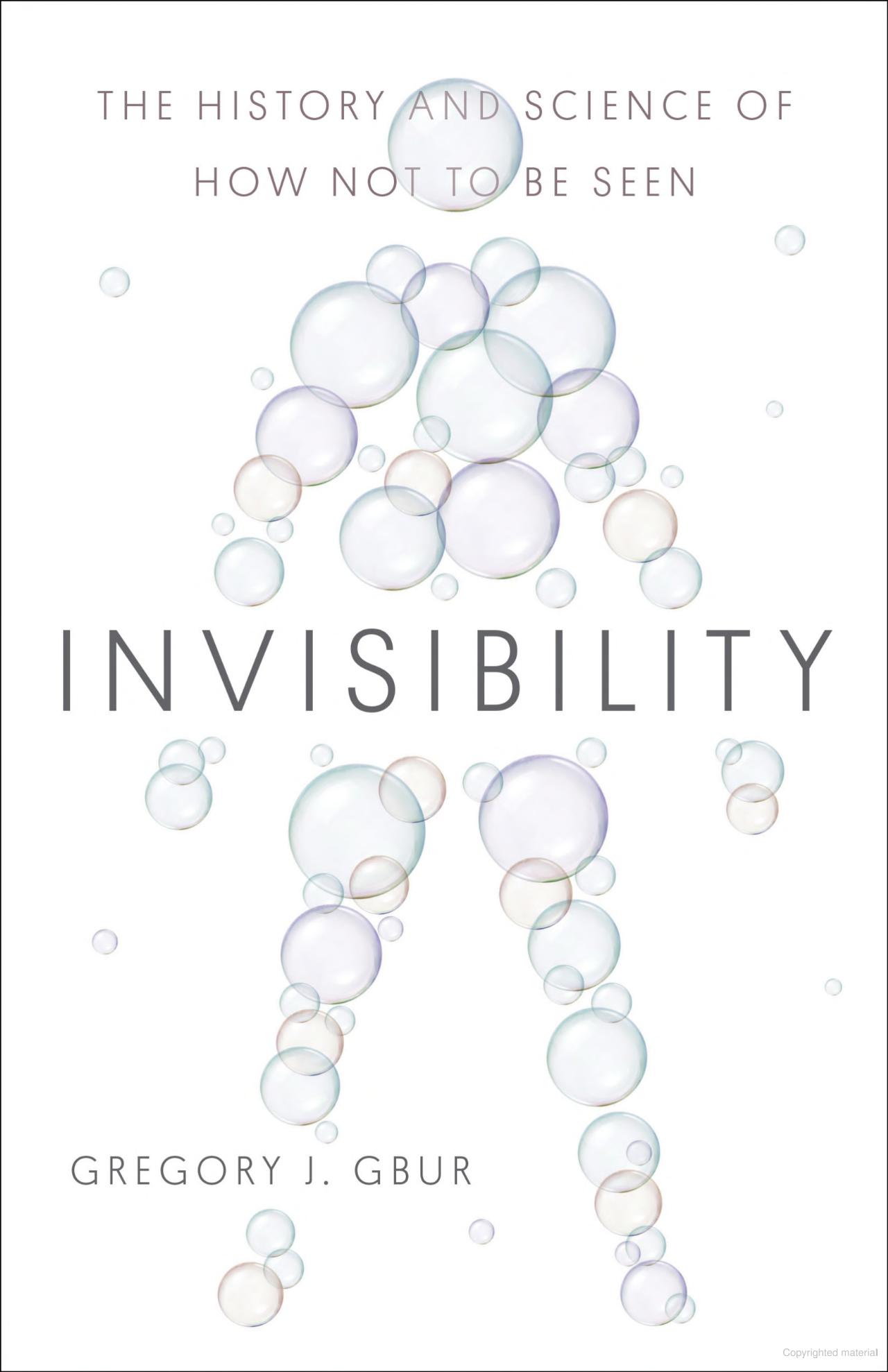Charlotte optical physicist Gregory J. Gbur turned to stacks of science fiction stories, a treasure trove of horror films, and his scientific expertise and discoveries when writing his new book, “Invisibility: The History and Science of How Not to Be Seen.”
“Invisibility” is not a purely scientific book, although certainly Gbur has written his share of those. This is an entertaining book for readers curious about one of the most popular plot devices from science fiction and an understandable discussion of the scientific concepts that one day might transform these tales into truth.
“There is a long history in both science and science fiction of people trying to imagine how things might be invisible or how invisibility might be related to interesting phenomenon,” said Gbur, who arguably is the world’s leading expert on invisibility fiction.
“My book looks at the earliest science fiction stories about invisibility from 1859 all the way to modern-day research as people today try to figure out how we can make an invisibility cloak and what other strange phenomena we can do,” Gbur said. “The book is really made up of the stories of what people were thinking at the time they were making various discoveries, how they were making them, and the troubles they had.”
Gbur, named an international Optica Fellow for his significant research in coherence theory, singular optics and the intersection of these disciplines, studies invisibility and related phenomenon as one aspect of his diverse research agenda.
“I still in fact do some research on invisibility,” he said. “I have an academic paper out now for review that talks about things that I write about in “Invisibility.” My Ph.D. work, which I completed in 2001, was on invisibility-related stuff. The main academic papers that caused invisibility cloaks to become a popular research topic didn’t come out until 2006. So, I say that I was doing invisibility before it was cool, as kind of a hipster invisibility theorist, and also, because of my background, I had a front row seat to all the discussions that were happening about invisibility.”
A Publishers Weekly Top 10 Science Book, “Invisibility” was reviewed in The New York Times and featured as a “Must Read” book by the Next Big Idea Club. Gbur recorded a short talk about the book for the Next Big Idea Club, and site curators Susan Cain, Malcolm Gladwell, Adam Grant and Daniel Pink will include it in a book list they will narrow to a handful of finalists and, ultimately, to two official season selections.

Gbur also joined renowned astrophysicist and science communicator Neil deGrasse Tyson and guest host and comedian Negin Farsad for a StarTalk appearance with a lively discussion of transparency versus invisibility, how metamaterials help us interact with different wavelengths, what light has to do to make something invisible and other topics.
Gbur’s book is geared particularly for readers with interests in science, history and science fiction, with a writing style honed through Gbur’s posts on his two blogs on horror fiction, physics, and nature, including Skulls in the Stars. “Invisibility is written without equations and without extremely technical descriptions,” he said. “I really try to explain things in understandable terms, embracing the weirdness in both science and science fiction, and I try to keep it fun.”
Fans will note that the book subtitle pays tribute to a classic sketch by British comedy troupe Monty Python, and in addition to the standard bibliography, it also features an invisibibliography, both signaling that this volume is not meant to be a boring slog of a read.
Gbur’s first book for a non-scientific audience, “Falling Felines and the Fundamentals of Physics,” also published by Yale University Press, explored the science of falling cats righting themselves as they land on their feet and related phenomenon. Gbur, who has fostered more than 20 cats and currently has 5 of his own, had set aside the intended book about invisibility when he was drawn to the cat topic. He made sure to include a historic photograph related to cats and invisibility in his new publication, and he’s decided that every future book will feature a cat illustration.
Here are a few more thoughts from Gbur about invisibility and related topics.
Do you think invisibility will be possible in the future, or do you think it will remain just part of science fiction?
It is always hard to predict the future in science, so we should recognize that new information can always change things. I imagine we will see some remarkable demonstrations of near-invisibility in the future, though I suspect that these will be primarily tech demonstrations and not products put to use for sinister purposes or otherwise. The construction and design of invisibility devices seems too challenging, and thus probably cost prohibitive. I do believe that the insights that we have learned from the theory of invisibility, and the advances that come from studying the possibility of invisibility, will have many benefits to optical technology in the future — even if we cannot see them directly.
How does science fiction interact with the science of invisibility?
It is fascinating to go back and look at science fiction stories about invisibility. There are way more of these than people realize. I was myself surprised by how many science fiction invisibility stories I found that nobody talks about any more. People writing about invisibility in science fiction felt they needed to at least justify it somehow using the science that was available at the time. The science fiction gives this sort of snapshot of the science of its era, including optics.
H.G. Wells, when he wrote “The Invisible Man,” knew enough optics to try to explain the optics side of whether an object could be invisible. But he also had to try and explain how might one achieve invisibility. He drew upon the fact that X-rays had been discovered only a couple of years earlier, and everybody was confused by X-rays. They saw X-rays as a form of invisibility because there were images where a person was see-through. There were newspaper articles about people selling X-ray-proof underwear. People were afraid they were going to be spied on when they were walking down the street.
They also at times got it pretty close to how we now imagine invisibility cloaks to work. There were a number of authors that ended up using the same analogies that the modern invisibility cloak people ended up using to explain how it works.
How did the scientific research you do influence the book?
As I was writing the book, it evolved not just into the story of invisibility, but it ended up being closely tied to the history of optics itself and how our understanding of light has evolved. I hope that when people read this, they’ll gain a better understanding of light and how light works. That is something that most people don’t get a whole lot of exposure to in school. Basic physics classes talk just a little bit about light and optics and how it works. Even a lot of physicists don’t delve very deeply into optics. So, part of my hope is just to make the whole science of light a bit more accessible, and in a fun way by talking about how our understanding of light has also driven our understanding of how invisibility might work.
Why does understanding optical science, at least to a certain degree, matter, and why do you describe the field as beautiful?
It matters if we understand optics simply because it’s a beautiful field of study, and not a lot of people understand it. It’s also worth understanding because so much of our modern technology is based on optics. For example, our Internet communications, our phone communications, often are transmitted through fiber optic cables, which all really depend on a deep understanding of optics.
Optics is beautiful partly because of the images we can make of some of the phenomena. Everybody has seen rainbow patterns and interference patterns when you mix different light waves together, especially colored light waves. There are so many complicated phenomena that produce these elegant images.
For me also, a lot of the beauty in optics is just how well the subject works and how well it all fits together. It’s a mature enough field now that we have this deep understanding of it, and when you make these connections of why things work the way they do, it’s lovely to see it all come together.
What lies ahead with the science?
There have been so many unusual and interesting discoveries about how light interacts with matter, and there is a possibility that much more of our society may change and be transformed by these recent discoveries that are connected somewhat to invisibility. It’s not that we’re going to have people walking around in invisibility cloaks but that the knowledge that we’ve learned from studying invisiblity may turn into more interesting things.
Modern advances in optics have changed the way we look at things like cameras and traditional lenses, as just one example, like with our Center for Freeform Optics at UNC Charlotte. A lot of the current discussion is around metamaterials, or the idea that you can design materials that have optical properties that are not found in nature.
Amazing optics being done now may transform our society. I hope this book will give people a little bit of an understanding of where that may take us.


Words and Images: Lynn Roberson








